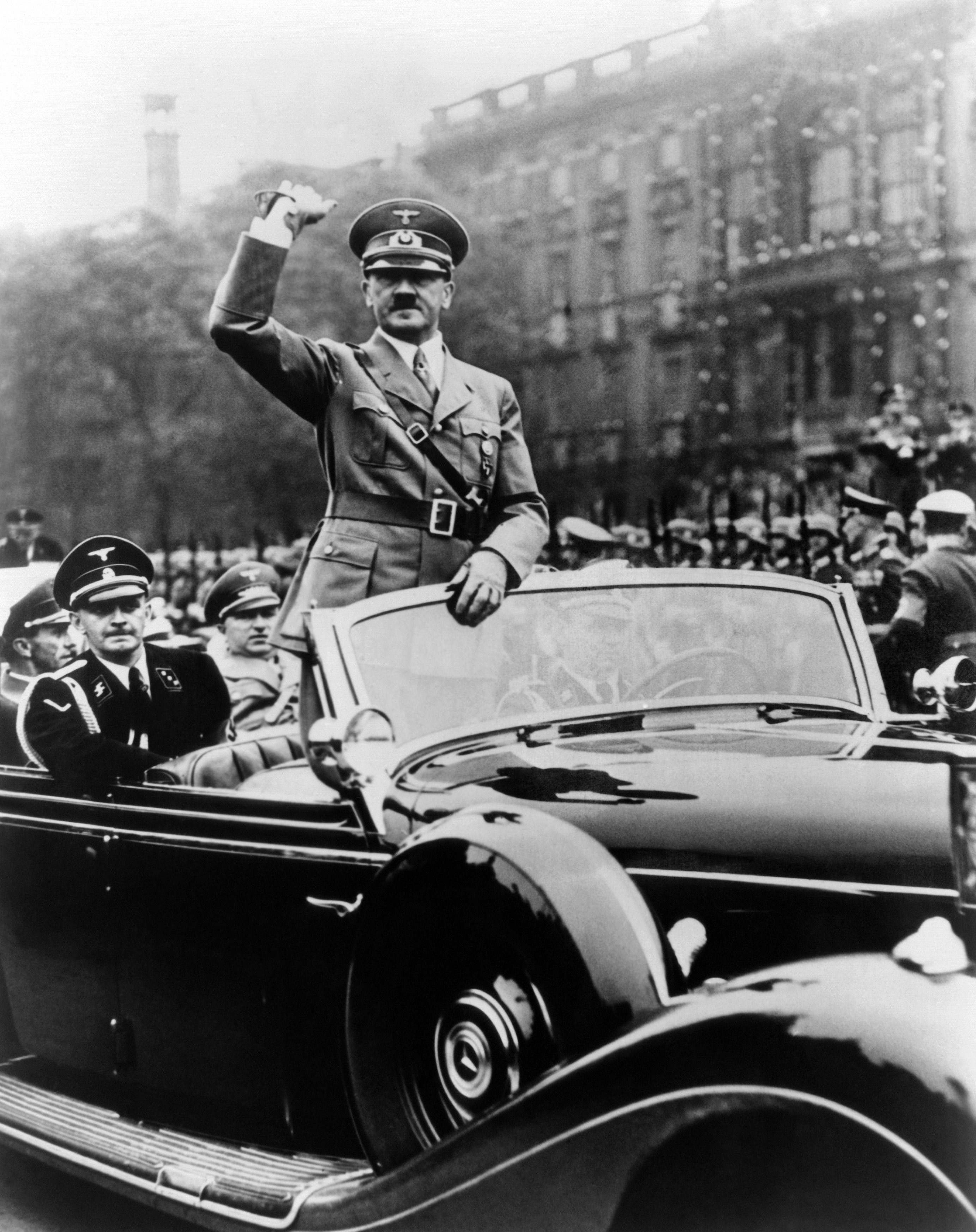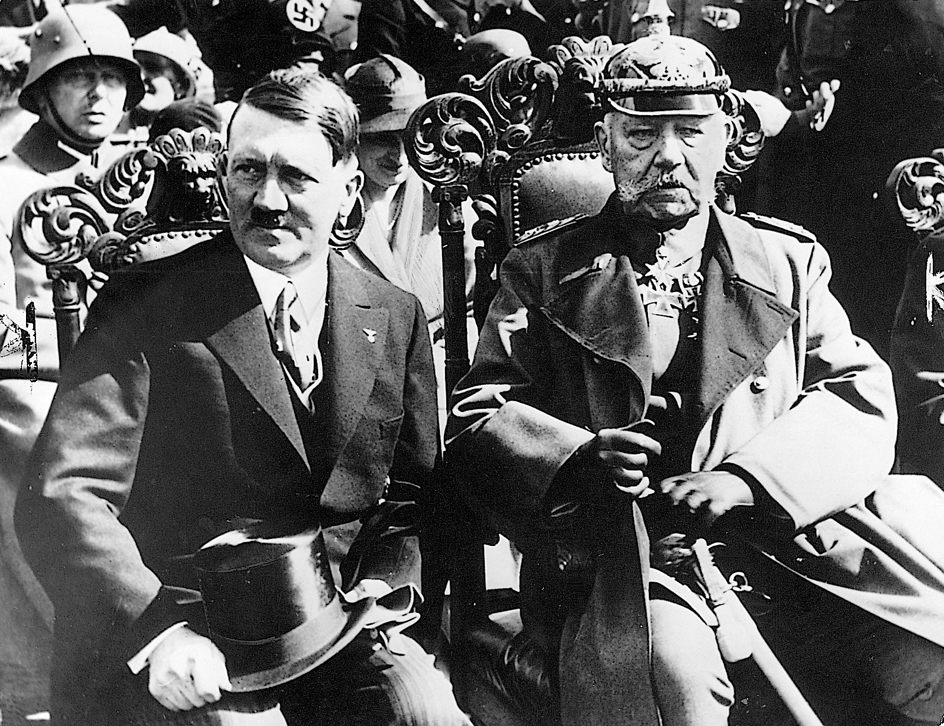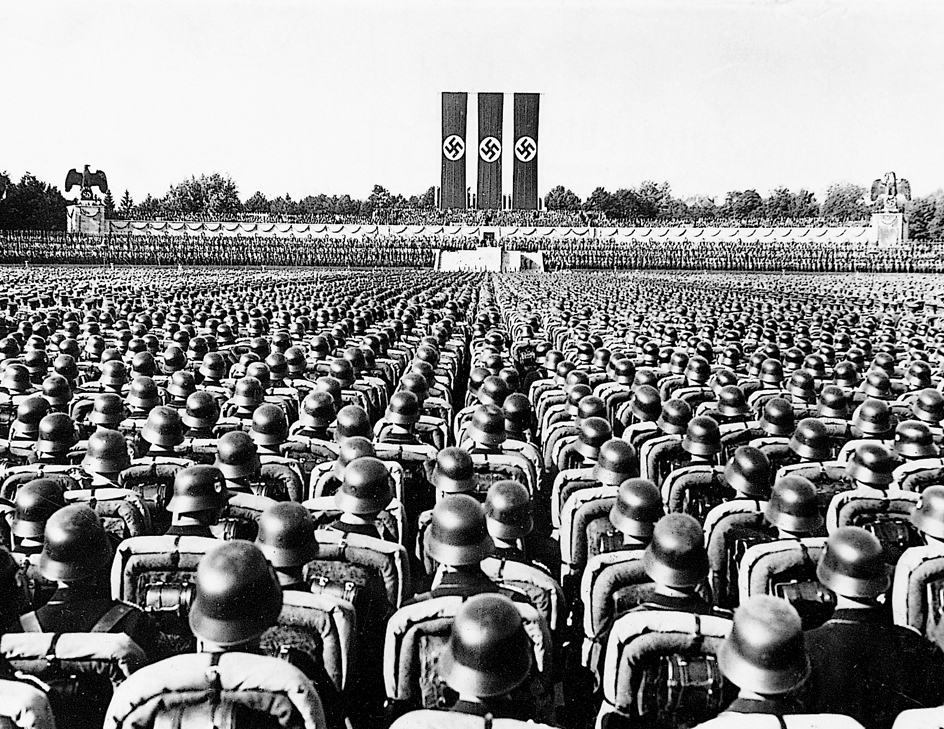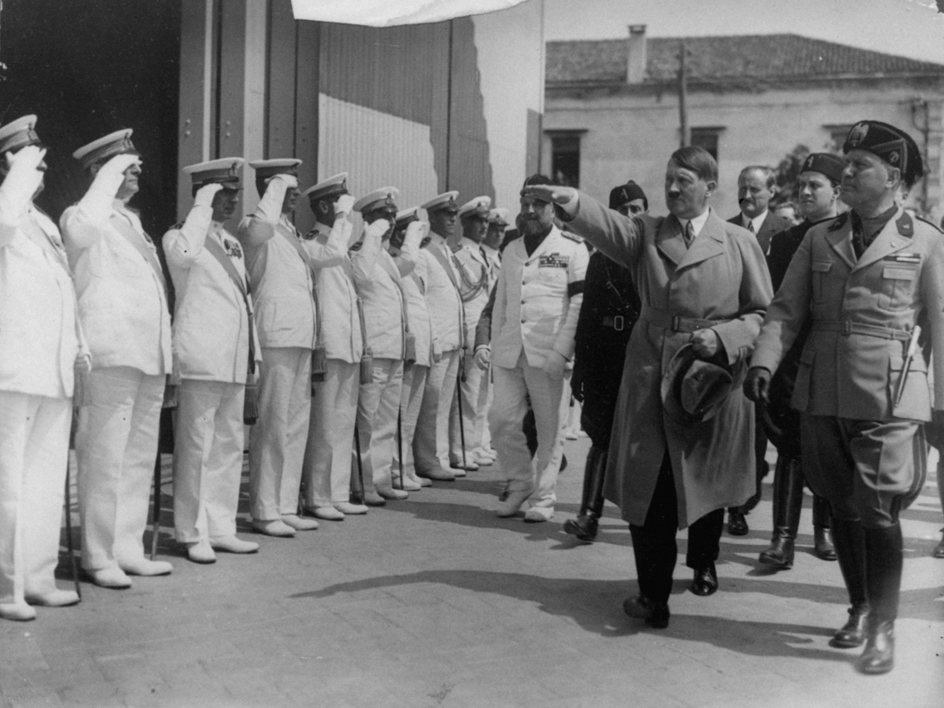Hitler, Adolf (1889-1945), ruled Germany as dictator from 1933 to 1945. He turned Germany into a powerful war machine and provoked World War II in 1939. Hitler’s forces conquered most of Europe before they were defeated in 1945.

Hitler spread death as no person has done in modern history. “Have no pity! Act brutally!” he told his soldiers. He ordered tens of thousands of those who opposed him to be executed, and hundreds of thousands to be thrown into prison.
Hitler particularly persecuted Jews. He ordered them removed and killed in countries he controlled. Hitler set up concentration camps where about 4 million Jews were murdered. Altogether, Hitler’s forces killed about 6 million European Jews as well as about 5 million other people that Hitler regarded as racially inferior or politically dangerous.
Adolf Hitler began his rise to political power in 1919, the year after World War I had ended. The German Empire had been defeated, and the nation’s economy lay in ruins. Hitler joined a small group of men who became known as Nazis. He soon became their leader. Hitler and his followers believed he could win back Germany’s past glory. He promised to rebuild Germany into a mighty empire that would last a thousand years.
Many people did not take Hitler seriously. But his fiery words and brilliant blue eyes seemed to hypnotize those who listened to him. Many Germans believed he was their protector and friend. His emotional speeches made crowds cheer “Heil, Hitler!” (“Hail, Hitler!”).
Hitler became dictator of Germany in 1933 and quickly succeeded in regaining some territories taken from Germany as a result of World War I. He threatened war against Czechoslovakia in 1938 but was stopped by a combination of counterthreats and concessions. His forces invaded Poland in 1939. Then the United Kingdom, France, Australia, New Zealand, South Africa, and Canada declared war on Germany, and World War II began.
Loading the player...Adolf Hitler and the rise of the Nazi Party
Hitler had a clear vision of what he wanted, and he had the daring to pursue it. But his aims had no limits, and he overestimated the resources and abilities of Germany. Hitler had little regard for experts in any field. He regularly ignored the advice of his generals and followed his own judgment, even while Germany was being defeated in the last years of the war. Finally, as United States, British, and Soviet troops closed in on the heart of Germany, Hitler killed himself.
Early life
Boyhood.
Adolf Hitler was born on April 20, 1889, in Braunau, Austria, a small town across the Inn River from Germany. He was the fourth child of the third marriage of Alois Hitler, a customs official. Alois Hitler was 51 years old when Adolf was born. Adolf’s mother, Klara Polzl, was 28 years old. She was a farmer’s daughter.
Alois Hitler was born to an unmarried woman named Anna Maria Schicklgruber. A wandering miller named Johann Georg Hiedler married her about five years later. Hiedler died in 1856, when Alois was 20 years old, having never recognized Alois as his child. In 1876, Hiedler’s brother arranged for Alois to be registered as the legitimate son of Johann Georg and Maria Hiedler. The priest who made the entry spelled the name “Hitler.” Years later, before he came to power, some of Hitler’s political opponents called him Schicklgruber as an insult. Only four of Alois Hitler’s eight children lived to adulthood. Adolf had a sister, Paula; a half brother, Alois; and a half sister, Angela.
About six years after Adolf’s birth, his father retired and moved near Linz, Austria. Adolf received good marks in elementary school, but he was a poor student in high school. His low marks angered his harsh, ill-tempered father. Alois wanted his son to have a career as a civil servant. But the boy wanted to be an artist.
Alois Hitler died in 1903, and Adolf left high school 21/2 years later at the age of 16. His mother drew a widow’s pension and owned some property. Adolf did not have to go to work. He spent his time daydreaming, drawing pictures, and reading books.
Years in Vienna.
In 1907, Hitler went to Vienna, the capital of Austria-Hungary. He wanted to be an art student, but he failed the entrance examination of the Academy of Fine Arts twice. His mother died in 1907. Adolf had an income from the money his mother left her children and inherited some money from his aunt. He also claimed an orphan’s pension. Sometimes he sold his drawings and paintings. He lived comfortably and idly during most of his stay in Vienna, considering himself an artist.
Hitler also concerned himself with political observations, admiring the effective leadership and organization of the Social Democratic Workers’ Party in Vienna. He developed a growing hatred for Jews and Slavs. Like many German-speaking Austrians, Hitler became fiercely nationalistic. No form of government could last, he thought, if it treated people of different nationalities equally.
Corporal Hitler.
In 1913, Hitler moved to Munich, Germany. The Austrian Army called him for a physical examination, but he was found unfit for service.
World War I began in August 1914. Hitler volunteered immediately for service in the German Army and was accepted. He served valiantly as a messenger on the Western Front for most of the war, taking part in some of the bloodiest battles. He was wounded and twice decorated for bravery. But Hitler rose only to the rank of corporal. When Germany surrendered in November 1918, he was in a military hospital recovering from temporary blindness that resulted from his exposure in battle to mustard gas. He was deeply shaken by news of the armistice. He believed that the unity of the German nation was threatened and that he must attempt to save Germany.
Rise to power
Defeat in World War I shocked the German people. Despair and turmoil increased as the army returned to a bankrupt country. Millions of Germans could not find work. A socialist-liberal republic replaced the defeated empire (see Germany (The Weimar Republic)).
After World War I, Germany was forced to sign the Treaty of Versailles. The treaty held Germany responsible for the war. It stripped the nation of much territory and restricted the German Army to 100,000 men. It also provided for a 15-year foreign occupation of an area of western Germany called the Rhineland. But the harshest part was the demand that Germany pay huge reparations (payments for war damages). The sums demanded by the treaty were so great that they made peace difficult. Nationalists, Communists, and others attacked the new government. The nationalists demanded punishment for the “criminals” who had signed the treaty.
Birth of the Nazi Party.
After Hitler recovered from the mustard gas, he returned to Munich and remained in the army until March 1920. In the autumn of 1919, he began to attend meetings of a small nationalist group called the German Workers’ Party. He joined the party and changed its name to the National Socialist German Workers’ Party. The group became known as the Nazi Party. The Nazis called for the union into one nation of all Germans, including the Austrians and German minorities in Czechoslovakia and other countries. They demanded that citizens of non-German or Jewish origin be deprived of German citizenship, and they called for the cancellation of the Treaty of Versailles.
Hitler was a skillful politician and organizer. He became leader of the Nazis and quickly built up party membership—partly by his ability to stir crowds with his speeches. Hitler attacked the government and declared that the Nazi Party could restore the economy, assure work for all, and lead Germany to greatness again.
Hitler also organized a private army he called storm troopers. He used brown-shirted uniforms and the swastika emblem to give his party and the storm troopers—known as the SA—a sense of unity and power (see Swastika). The troopers fought the armies of the Communist, Social Democratic, and other parties who opposed Nazi ideas or tried to break up Nazi Party rallies. By October 1923, the storm troopers numbered 15,000 members. They had a considerable number of machine guns and rifles.
The Beer Hall Putsch.
In 1923, Germany was in deep trouble. France and Belgium had sent troops to occupy the Ruhr District, the chief industrial region. German workers there responded by going on strike. The strike aggravated a crisis in Germany’s economy, which had already been weakened by the reparations payments, and German money lost almost all value. Communist and nationalist revolts flared up throughout Germany, and the state of Bavaria was in open conflict with the central government in Berlin. Hitler saw an opportunity amid these troubles to overthrow both the Bavarian and national German governments.
On Nov. 8, 1923, at a rally in a Munich beer hall, Hitler proclaimed a Nazi revolution, or putsch. The next day, he tried to seize the Bavarian government in what became known as the Beer Hall Putsch. Hitler, supported by the German General Erich F. W. Ludendorff, led over 2,000 storm troopers on a march against the Bavarian government. But state police opened fire and stopped the procession, killing 16 marchers. The plot failed. Hitler was arrested and sentenced to five years in prison.
Mein Kampf.
While he was imprisoned, Hitler began writing his book Mein Kampf (My Struggle). In the book, he stated his beliefs and his ideas for Germany’s future, including his plan to conquer much of Europe. Territories lost in World War I would be recovered. Austria and parts of Czechoslovakia where Germans lived would be added to Germany. The growing German nation would seize lebensraum (living space) from Poland, the Soviet Union, and other countries to the east.
Hitler also wrote that Germans represented a superior form of humanity. They must stay “pure,” he said, by avoiding marriage to Jews and Slavs. Hitler blamed the Jews for the evils of the world. He accused them of corrupting everything of ethical and national value. He said: “By defending myself against the Jews, I am doing the Lord’s work.” Democracy, said Hitler, could lead only to Communism. A dictatorship was the only way to save Germany from the threats of Communism and Jewish treason.
Rise of the Nazis.
Hitler was freed about nine months after his trial. He left prison in December 1924.
Great changes had taken place in Germany during 1924. A schedule for Germany’s reparations payments helped stabilize the German currency, and the nation showed signs of recovering from the war. Most people had work, homes, food, and hope for the future.
The government had outlawed the Nazis after the Beer Hall Putsch. Many party members had drifted into other political groups. After Hitler was released from prison, he began to rebuild his party. He gradually convinced the government that the party would act legally, and the government lifted its ban on the Nazis. Hitler won friends in small towns, in labor unions, and among farmers and a few business people and industrialists. He also set up an elite party guard, the Schutzstaffel, known as the SS. By 1929, though the Nazis had not yet gained substantial voter support, their organization and discipline had made them an important minority party.
By this time, Hitler had assembled some of the people who would help him rise to power. They included Joseph Goebbels, the chief Nazi propagandist; Hermann Göring, who became second in command to Hitler; Rudolf Hess, Hitler’s faithful private secretary; Heinrich Himmler, the leader of the SS; Ernst Rohm, the chief of the SA; and Alfred Rosenberg, the party philosopher.
In 1930, the worldwide Great Depression hit Germany. Workers again faced unemployment and hunger. That same year, Germany agreed to the Young Plan of 1929 to reschedule reparations payments. In 1929, Hitler had launched a nationwide campaign to defeat the plan. This campaign helped him become a major political force throughout the country. He led protest marches, organized mass meetings, and delivered speeches all over Germany.
Hitler used his old arguments in the campaign against the Young Plan and in a national election campaign that took place in 1930. But he toned down his violent speeches against Jews, which had failed to attract many votes. Hitler promised to rid Germany of Communists and other “enemies” and to reunite Germany and all the other parts of Europe in which German was spoken.
In 1932, five major elections were held in Germany as its leaders struggled to give the nation political stability. In the July elections for the Reichstag (parliament), the Nazis became Germany’s strongest party, receiving nearly 38 per cent of the vote. Leaders of the other parties offered Hitler Cabinet posts in exchange for Nazi support. But as leader of the strongest party, he refused to accept any arrangement that did not make him chancellor (prime minister) of Germany.
The majority of the German people and the leading politicians did not want Hitler to become chancellor. They understood that he would make himself dictator and set up a reign of terror. Germany’s president, Paul von Hindenburg, also had serious misgivings about Hitler. But the 85-year-old Hindenburg, persuaded by his friends and his son Oskar, accepted Hitler’s promise to act lawfully if he were named to form a government. On Jan. 30, 1933, Hindenburg named Hitler chancellor. 
Dictator of Germany
There were only two Nazis in the Cabinet besides Hitler—Göring and Wilhelm Frick. The rest of the 11-member Cabinet was made up of politicians who were more moderate than the Nazis. The vice chancellor, Franz von Papen, and his political allies thought this arrangement would limit Hitler’s power. But Hitler had never settled for anything less than full control. He moved steadily toward dictatorship. There was no place for freedom under his government, which Hitler called the Third Reich (see Reich).
The New Order.
The Nazis, through Frick’s key position as minister of the interior, controlled all national police authority. Göring controlled the Prussian police. An emergency decree signed by Hindenburg on Feb. 4, 1933, gave the Nazis legal authority to prohibit assemblies, to outlaw newspapers and other publications, and to arrest people on suspicion of treason. The Nazis were thus able to put down much of their political opposition. Göring created an auxiliary police force made up of thousands of storm troopers and ordered them to shoot in encounters with “enemies.”
On Feb. 27, 1933, a fire began that destroyed the Reichstag building. Many historians believe that it was planned by the Nazis. A pro-Communist Dutch anarchist was found at the site of the fire and admitted that he had set it. The Nazis quickly blamed the Communists. Hindenburg signed another emergency decree that gave the government almost unlimited powers.
Elections for a new Reichstag were held on March 5, 1933. Hitler hoped to win more than 50 per cent of the vote for the Nazi Party. But the party received only 43.9 per cent despite using terror to influence voters.
After the election, the Communist deputies were arrested or not admitted to the Reichstag. This gave the Nazis a majority of the seats. On March 23, 1933, the Nazi-dominated Reichstag passed a law “for the removal of distress from the people and the state.” This law, known as the Enabling Act, gave the government full dictatorial powers and, in effect, suspended basic civil and human rights for four years. When the president had signed it, Hitler had a firm “legal” basis on which to govern as he pleased. He had also destroyed the constitution through outwardly legal means.
By mid-July 1933, the government had outlawed freedom of the press, all labor unions, and all political parties except the Nazis. The Gestapo (secret state police) hunted down the enemies and opponents of the government. People were jailed or shot on suspicion alone. By the time Hindenburg died in August 1934, Hitler ruled Germany completely. He assumed the title Fuhrer und Reichskanzler (leader and reich chancellor).
The Nazis used the press, radio, and films to flood Germany with propaganda praising the New Order, Hitler’s term for his reordering of German society and for his plans to reorder the rest of Europe. The regime applauded military training, rearmament, national pride, and industry. Jews were forced out of the civil service, universities and other schools, and the professions and managerial positions. In 1935, German Jews were declared citizens of lesser rights. Thousands left the country. Many who stayed were sent to concentration camps along with hundreds of thousands of political suspects. A person needed official permission to accept work, change jobs, move, or travel abroad. The government regulated wages, housing, and production of goods. All workers and employers were supposed to belong to the German Labor Front, which was intended to replace Germany’s labor unions. Through the Labor Front, the government regulated production, wages, working hours, and leisure activities. 
Hitler also set up organizations for young people between the ages of 6 and 18. These groups included the Hitler Youth for boys 14 years and older and the Society of German Maidens for girls 14 years and older. The organizations were designed to condition German children to military discipline and to win their loyalty to the Nazi government. All German children were required to join such groups from the age of 10. They wore uniforms, marched, exercised, and learned Nazi beliefs. The Nazis taught children to spy on their own families and report anti-Nazi criticism they might hear.
A network of spies kept watch on the German people and maintained an atmosphere of terror. The Reichstag met only to listen to Hitler’s public speeches. Judges and courts continued to function, but Hitler or his lieutenants reversed any decision they did not agree with.
The road to war.
From 1933 onward, Hitler prepared Germany for war. He rearmed the nation, first secretly, then in open violation of the Treaty of Versailles. No nation acted to stop him, and so Hitler’s steps became bolder. Hitler planned to establish Germany as the world’s leading power and to destroy the Jewish people.
In 1936, Hitler sent troops into the Rhineland, again violating the Treaty of Versailles. His generals had opposed this dangerous challenge to France. But Hitler guessed correctly that France would not stop him. The stationing of German troops in the Rhineland was the first of the Nazi dictator’s victories without war.
In March 1938, Hitler’s troops invaded Austria. Austria then became part of Germany. In September, France and Britain consented to Hitler’s occupation of the German-speaking areas of Czechoslovakia that had belonged to Austria-Hungary before World War I ended (see Munich Agreement). After this move, Hitler said he wanted no more territory. But after each success, he planned a new take-over. He took control of the rest of Czechoslovakia in March 1939.
Poland came next on Hitler’s list. But Britain and France took action to try to stop any further German expansion. They guaranteed Poland’s independence, saying that they would go to war against Germany if Hitler attacked Poland. Hitler doubted that they would do so. In August 1939, Germany and the Soviet Union signed treaties of friendship. They promised mutual cooperation, trade privileges, and neutrality in case of war with other countries. In a secret part of the treaties, the two nations planned to work to divide Poland and much of the rest of eastern Europe between themselves. On September 1, 1939, Germany invaded Poland. Britain and France declared war on Germany two days later.
World War II.
Hitler’s armies overran Poland in just a few weeks. In the spring of 1940, they easily conquered Denmark, Norway, the Netherlands, Belgium, Luxembourg, and France. Benito Mussolini, Italy’s dictator, declared war on France and Britain on June 10, 1940, when the defeat of France seemed certain. On June 22, 1940, France signed an armistice with Germany.

Britain fought on alone. A major German air offensive failed to weaken British resistance. Hitler kept delaying an invasion of Britain. Instead, he considered invading the Soviet Union. He explained to his generals that Britain would not surrender until its last potential ally on the European continent had been defeated.
In June 1941, the attack on the Soviet Union began. At first, the German forces made rapid progress. But their advance began to slow in November. By December, it was halted outside Moscow. An unusually bitter winter, Soviet reinforcements, and supplies sent by the United States helped the Soviet forces stop the Germans and begin to push them back during the winter. Renewed German attacks in 1942 and 1943 could not break through. During the Battle of Stalingrad, which lasted for five months during 1942 and 1943, the Soviets wiped out an entire German army of 300,000 men. This German defeat was a major turning point in the war.
While his empire lasted, Hitler directed the storm troopers, Nazi officials, and members of the army and the civil service in a campaign of mass slaughter. About 6 million Jews—over two-thirds of the Jews of Europe—were murdered. More than 3 million Soviet prisoners of war were starved and worked to death. Hitler’s victims also included large numbers of Poles, Slavs, Roma, Jehovah’s Witnesses, priests and ministers, mental patients, gay people, Communists, and other political opponents.
The German resistance had tried since 1938 to kill Hitler and overthrow the Nazis. But repeated plots failed. On July 20, 1944, Hitler narrowly escaped death when a German Army officer placed a bomb in Hitler’s briefing room.
Early in 1945, the Allies marched into the heart of Germany against rapidly dwindling opposition. For a detailed story of Germany in the war, see World War II.
Death.
By April 1945, Hitler had become a broken man. His head, hands, and feet trembled, and he was tortured by stomach cramps. Eva Braun, Hitler’s mistress since the 1930’s, joined him at his headquarters in a bomb shelter under the Reich Chancellery in Berlin. She and Hitler were married there on April 29. The next day, they killed themselves. Aides burned their bodies. Seven days later, Germany surrendered.
